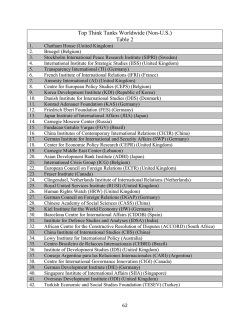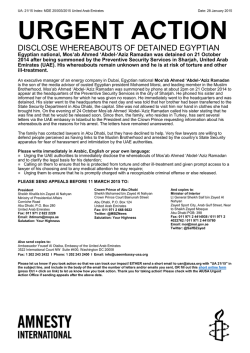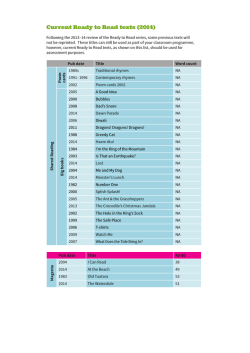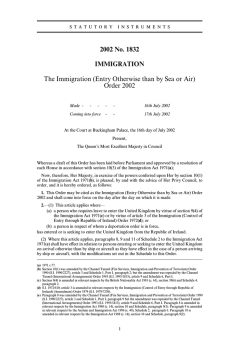
Studien zur Altägyptischen Kultur Nr. 43 (2014) - Abstracts
Studien zur Altägyptischen Kultur Nr. 43 (2014) - Abstracts Kahl (Hg.), Jochem and Kloth (Hg.), Nicole Originalveröffentlichung in: URL: http://archiv.ub.uni-heidelberg.de/volltextserver/18140/ URN: urn:nbn:de:bsz:16-heidok-181400 Datum: 2. February 2015 Bitte beachten Sie die Nutzungsbedingungen: http://archiv.ub.uni-heidelberg.de/volltextserver/help/license_urhg.html ABSTRACTS: STUDIEN ZUR ALTÄGYPTISCHEN KULTUR 43 (2014) Abdel-Raziq, Abdalla Three Late Middle Kingdom Stelae from Al-Salam School Museum, Assiut S. 1-16, Taf. 1-3 Publication of three stelae, now in the archaeological Museum in Al-Salam School at Assiut bearing the inventory nos. 202, 205 and 206 dating to the late Middle Kingdom Period (Senwosret III and later), including comments on style, iconography, paleography, and dating criteria. Antoine, Jean-Christophe Social position and the organisation of landholding in Ramesside Egypt. An analysis of the Wilbour Papyrus S. 17-46 The Wilbour papyrus is a major source for the study of the sociology of Ancient Egypt but the enormous amount of contained data needs powerful statistical tools to obtain significant information. As this information is grasped through the frame of a regional land register, confrontation to external sources is needed. Using such methods, it can be showed that the pattern of landtenure in P Wilbour fairly reflects social hierarchy among the elite and middle class and wholly conforms to the pattern of social prestige and hierarchy provided by archaeological material such as house size and graves goods for the New Kingdom, or to the organisation of the society as exemplified in the Amenope Onomasticon. Moreover P Wilbour allows the unique opportunity of identifying the respective role of endogenous factors and of state policies on the organisation of social classes in provincial Egypt during the Ramesside Period. Breyer, Francis Vorlagen zur „Punthalle“ von Dair al-Baḥrī aus dem Alten Reich. Philologisch-epigraphische, textkritische und ikonographische cruces im Zusammenspiel von Darstellungen und Inschriften S. 47-91 It can often be read that Queen Hatschepsut had sent a magnificent expedition to Punt, because she had her mortuary temple at Dair al-Baḥrī be decorated with scenes representing just that. But a closer look at the reliefs and especially at the accompanying texts reveal that these depictions must have been copied from much earlier material, probably going as far back as the Old Kingdom. A series of different graphematical and grammatical archaisms as well as several discrepancies between textual and pictorial message clearly shows that those reliefs and inscriptions, which are directly related to the depiction of Punt, more probably stem from an ancient ›Vorlage‹ rather than having been inserted by clever scribes to give the reliefs a more ancient appearance. Di Biase-Dyson,Camilla Multiple Dimensions of Interpretation. Reassessing the Magic Brick Berlin ÄMP 15559 S. 93-107, Taf. 4 This article suggests employing a variety of perspectives when subjecting a textual object to analysis. On the basis of the Magic Brick Berlin ÄMP 15559, the textual and material features of an object as well as its conceivable archaeological context are brought into play as complementary dimensions of interpretation. We additionally appraise these three elements in light of comparable textual and archaeological material. In this way, not only the functionality of the object but also the interpretation of the text can be reconsidered. The textual interpretation in particular, which forms the focus of the article, makes reference to Translation Studies and employs interlinear morphemic glossing to draw its conclusions about the particularities of this object. Díaz Hernández, Roberto A. The Role of the War Chariot in the Formation of the Egyptian Empire in the Early 18th Dynasty S. 109-122 Little attention has been paid to the important role of the Egyptian war chariot in the formation of the Egyptian Empire at the beginning of the New Kingdom. The purpose of the present paper is first to examine the role of the war chariot in Egyptian victories recorded in biographies, such as that of Ahmose, son of Ibana, and in royal annals such as those in the inscriptions of Thutmose III. Next, the Asiatic and the Egyptian chariots will be compared and their use taken as evidence for their iconographic representations in order to spot relevant differences that might explain Egyptian victories. Lastly three chronological phases in the military use of the war chariot in Egypt at the beginning of the New Kingdom will be put forward, and it will be argued that it was an important factor for Egyptians’ victories over their enemies, for, without it, they would not have been able to defeat them. However, those victories were not achieved by innovation either in the structure or in the use of the war chariot, but rather by other reasons such as military strategy. Hellum, Jennifer Toward an Understanding of the Use of Myth in the Pyramid Texts S. 123-142 The lack of narrative myth in Old Kingdom religious literature has long been the subject of discussion. Recently, the discussion has moved from whether myth existed in the Old Kingdom, to how it existed. The Pyramid Texts provide an excellent testing ground for the study of myth. Each king possesses a distinct group of texts, different from the other kings’, but they are all used for the same goal and in exactly the same physical context. It is proposed that the architecture of the textual chambers works as a boundary for the texts, and that in doing so, it provides a framework for understanding the corpora of texts as a myth in themselves. Thus, the architecture is the metaphorical beginning and end of the myth, and the texts can be examined as the content of that myth. Together, they comprise a metamyth, a myth that includes the physical context of the texts and their literary content. Hsu, Shih-Wei Pharaos Körper: Tiere als bildliche Ausdrücke in den Königsinschriften S. 143-157 This paper aims to investigate the use of the figurative language of the ancient Egyptian royal inscriptions, with a special focus on the animal similes and metaphors. The pharaoh’s body symbolizes royal physical power and strength. This royal power can be shown both by the iconographic and written images. Through the different kinds of characters of animals the king can represent his power, elation, anger, fear, awe or speed. The usage, function and purpose of the figurative language referring to animals will also be treated. Kahl, Jochem Assiut – Theben – Tebtynis. Wissensbewegungen von der Ersten Zwischenzeit und dem Mittleren Reich bis in Römische Zeit S. 159-172 Tomb inscriptions, features of tomb architecture, and tomb scenes from First Intermediate Period and Middle Kingdom Asyut are attested in tombs at Thebes and other Egyptian sites during later periods. Papyri from the Roman Period, once stored in a library in Tebtynis and representing inscriptions from Asyuti tombs more than 2.000 years older, mark the end of this long tradition of knowledge transfer. The interplay of monumental and library traditions allows insight into some processes of textual transmission, which only seldom can be reconstructed. During the transmission, the function of the texts changed from funerary texts to commemorative texts. Klotz, David Hibis Varia (§ 1-3): Diverse Liturgical Texts from Hibis Temple S. 173-207 Miscellaneous texts from the inner chapels from Hibis Temple are better understood by considering textual parallels from other temples and papyri from the New Kingdom through the Ptolemaic Period. These scenes include: (1) A procession of New Year’s vases, with a special reference to water generated underground in Heliopolis; (2) A widely attested offering text for idmy-linen; (3) A liturgical hymn celebrating the royal inheritance of Wennefer. Lapp, Günther Totentexte der Privatleute vom Ende des Alten Reiches bis zur 1. Zwischenzeit unter besonderer Berücksichtigung von Sargkammern und Särgen S. 209-222 The paper deals with texts of private persons from the end of the Old Kingdom to the first Intermediate Period. In the first part ritual texts are collected which enable the deceased to pass from the world of the living to the realm of the dead. Contrary to these, texts which might describe the life in the hereafter are extremely rare in this period. The main source of information of this kind comes from the coffin texts and the question when such texts appear for the first time is the topic of the last section. Malaise, Michel Le calathos sur la tête d’Isis: une enquête S. 223-265 Il est bien connu que la couronne d’Isis la plus répandue durant la période gréco-romaine est le basileion. L’épouse de Sérapis est néanmoins aussi dotée du calathos, presque toujours lorsqu’elle présente un caractère syncrétique (Isis-Tychè/Fortuna, Isis-Déméter, IsisAphrodite). Ce choix n’a guère suscité de recherches; c’est pourquoi nous tentons d’en trouver les raisons et de déterminer l’époque de son apparition sur la tête de la déesse égyptienne. Dans la mesure où le calathos est étranger à l’imagerie pharaonique, on doit bien chercher ailleurs l’origine de cet attribut. La réponse est malaisée parce que toutes ces divinités paraissent avoir ignoré le port du calathos avant l’ère hellénistique. De surcroît, la combinaison de traits iconographiques ou l’association écrite du nom de ces déesses ne nous révèle que rarement si nous nous trouvons devant des rapprochements ou de véritables assimilations. Le premier indice clair nous est fourni par l’arétalogie isiaque grecque de Maronée (deuxième moitié du IIe s. – première moitié du Ier s.) qui témoigne d’une fusion entre Isis et Déméter. Sur la base des données iconographiques et textuelles, le calathos ne semble pas passer sur la tête d’Isis aprés les alentours du milieu du IIe s. av. J.-C., soit un peu avant son adoption par Sérapis. Le calathos n’est pas une coiffe réelle, mais bien un emblème posé artifiellement sur le sommet du crâne. Dans le cas d’Isis, il pourra être associé au basileion. Metawi, Dina The False Door of WDa-©ri (Cairo Museum, without number) S. 267-276, Taf. 5-7 Publication of a limestone false door stela in the basement of the Cairo Museum (without number), including commentary on its style, iconography, and palaeography. The owner of the false door, a man named ‘WDa-©ri’, held a number of important titles, such as ‘the superintendant of the xntyw-S officials (tenants) of the palace (sHD xntyw-S pr-aA), the overseer of apportionments (imy-rA wpt), and the regulator of phyles of the pyramid ‘Established is the Perfection of Meryre’(mty n sA Mry-Ra Mn-nfr). The occurrence of Pepi I’s later throne name (Meryre) in the inscriptions offers a terminus ante quem non for the false door. Other stylistic and palaeographic details suggest a later date possibly in the early years of Pepy II’s reign. O’Rourke, Paul F. The Book of the Dead of Ankhefenkhonsu in Brooklyn S. 277-315, Taf. 8-12 Individual manuscripts of the Book of the Dead from the Third Intermediate Period offer opportune chances to study comparative orthography and, more importantly, to examine the principles underlying the composition of funerary texts during this period. Papyrus Brooklyn 37.1840E, comprising eight chapters from the Book of the Dead corpus, provides a prime example of the importance of such a manuscript. This study includes a full transcription of the hieratic text with an apparatus criticus that gives variant writings from a number of contemporaneous manuscripts. Then follows a full translation with text notes and, finally, some thoughts on how the individual chapters for such a manuscript were chosen. Publication of Papyrus 37. 1840E, the Book of the Dead of the wab-priest of Amun Ankhefenkhonsu, belonging to the Egyptian Collection of the Brooklyn Museum. The author dates the Brooklyn Book of the Dead in the first half of Dynasty Twenty-one. Ramcke, Rainer Der Sothis-Zyklus und die zwei Anfänge des altägyptischen Verwaltungskalenders. Eine astronomische Simulation S. 317-358 Nach der Diskussion neuerlich vorgebrachter Bedenken gegen die Astronomie als Hilfswissenschaft für die altägyptische Chronologie rekonstruiert die vorliegende Untersuchung mit Hilfe einer auf den Beobachtungsort Memphis bezogenen astronomischen Computer-Simulation den konkreten Verlauf der ersten beiden Sothis-Zyklen. Mit der gleichen Planetariums-Software werden auch zwei astronomische Konstellationen ausfindig gemacht, welche den Anstoß zur Einführung des altägyptischen Verwaltungskalenders in den Jahren 2774/71 v. C. sowie zu einer eventuellen ursprünglichen Einführung des Kalenders um 3000 v. C. gegeben haben können. Eine Variation des für die heliakischen Siriusaufgänge maßgeblichen arcus visionis von 8,5° bis 9,5° führt schließlich zu dem Ergebnis, dass die darauf aufbauenden Rekonstruktionen der Sothis-Zyklen gut mit den historisch überlieferten julianischen Eckdaten übereinstimmen. Für das erste Jahr des dritten Sothis-Zyklus ergibt sich aus allen diesen Rekonstruktionen der enge Bereich 138-140 n. C. Der stark umstrittene Tagebucheintrag im Tempel von Illahun fällt nach den Ergebnissen dieser Untersuchung in den Zeitraum 1876 bis 1871 v. C. Ridealgh, Kim A Tale of Semantics and Suppressions: Reinterpreting Papyrus Mayer A and the So-called ‘War of the High Priest’ during the Reign of Ramesses XI S. 359-373 The ‘War of the High Priest’ is a phrase commonly used by scholars to refer to the so-called ‘suppression’ of the High Priest of Amun Amenhotep by the King’s Son of Kush Panehsy during the reign of the last Ramesside king, Ramesses XI. The precise date of this event is debated, but it likely occurred around Regnal Year 17 or 18 of Ramesses XI (c. 1089–1088 BCE). The sources that document the ‘War of the High Priest’ are limited (P. Mayer A, P. BM EA 10383, P. BM EA 10052, and the Karnak Inscription) and scholarly opinion on the topic is hotly divided. What is clear, however, is that the term ‘suppression’ used to refer to this event is ineffectual in conveying the nuances of the Egyptian term thj, and by translating thj as ‘suppression’ extreme connotations are imposed upon it that alter modern perceptions concerning the ‘War of the High Priest’. This study will add to the existing debate on the ‘War of the High Priest’ by examining the terminology surrounding the event through a lexical analysis of thj, analysing its uses in other textual contexts, scholarly interpretation, and its wider implications. Chronological issues and debates will be discussed only on the periphery. Rummel, Ute War, death and burial of the High Priest Amenhotep: the archaeological record at Dra’ Abu el-Naga S. 375-397, Taf. 13-15 The historical events at the end of the New Kingdom that constitute the prelude to the wHmmswt-era have been the subject of extensive scientific debate. So far, only textual sources have been available to evaluate this politically turbulent period, which was marked by a civil war against the High Priest of Amun, Amenhotep. By presenting the relevant findings obtained in the double tomb complex K93.11/K93.12 at Dra’ Abu el-Naga, the archaeological perspective is added to the discussion. One central concern is the date of Amenhotep’s death and burial and the destruction of K93.11/K93.12 in relation to the conflict with Panehsy. Moreover, the hypothesis of Amenhotep’s exile in the Great Oasis and the chronological placement of his brother’s Nesamun tenure as High Priest are also re-evaluated. Spalinger, Anthony John Eleventh Day, Twelfth Night: Further Remarks Concerning Three Feasts in Egyptian Civil Tooth S. 399-415 A discussion of the three most important Egyptian religious celebrations that occurred in the first month of the Civil Year. They cover days 18 through 20 and their importance can be determined from their connection to the end of the solar year and the start of the new one. Hence, the main chronological issue that links all three is one that can be seen in other civilizations, and in particular in the events surrounding 25 December and 6 January of our era. Stefanović, Danijela The overseer of mSa of the section of nfrw (stela London BM EA 1822) S. 417-421, Taf. 16 The aim of this article is the publication of the early Middle Kingdom stela London BM EA 1822, as well as the analysis of the title mr mSa n wart which is otherwise unattested. Theis, Christoffer Zu den an der Pyramide Lepsius XIII gefundenen Namen. Die Frage nach Nfr-k# und B#-k# S. 423-438 The article offers a new solution concerning the names that were discovered at the beginning of the 20th century on stoneblocks at the pyramid Lepsius XIII in Zāwīyat al-cAryān. It is argued that the stones bear the names of two kings: the cartouche of B#-k#, who is actually the builder of the tomb, and of Nfr-k#, an ephemeral king of the third dynasty. On the hypothesis that these were blocks of Lepsius XIV which were later reused, the name Nfr-k# can possibly be equaled with Horus %o+-b#, which leads to the conclusion that the use of a cartouche for the proper name is also attested within his reign and not just with c#-nXt(.w) in the middle of the third dynasty. El-Tonssy, Mohamed A. / Mohamed, Yossef Two Unpublished False Doors from Saqqara S. 439-455, Taf. 17-18 The aim of this article is to publish two Old Kingdom false doors that were found recently at Saqqara. The first false door (no.19543 in Saqqara Magazine) was made for the senior priest and tenant of the Pyramid Town of King Pepy II, Khaef-Menw. The second one (no.19545 in Saqqara Magazine) was made for the Royal Acquaintance, Nofer-Ihey. The workmanship on both false doors is excellent, and they can be dated with certainty to the Old Kingdom.
© Copyright 2024







